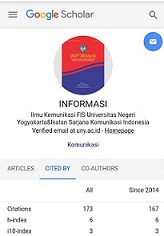The influence of the use of website-based learning media on engineering drawing materials
Aan Sukandar, Universitas Pendidikan Indonesia, Indonesia
Fikran Fauzul Zadi, Universitas Pendidikan Indonesia, Indonesia
Anggraili Salsabila Fikadinda, Universitas Pendidikan Indonesia, Indonesia
Wahid Maulana, universitas Pendidikan Indonesia, Indonesia
Abstract
The era of digitalization actually offers various conveniences. Learning can be done through various methods, not only conventional methods. The widespread use of the internet network must be utilized optimally in various fields. So that digital technology is very functional today to do online learning. The influence of the production of learning media with website-based technology on responses to the learning activities of the Engineering Drawing course, Mechanical Engineering Education Department. Learning media used through the web aims to be used as alternative teaching materials in the learning process in the hybrid learning era. The technology used allows users to access it on any device that has an internet network without having to eat up storage on the device, because the media only uses the internet network to access it. In the research conducted using quantitative descriptive methods. The results showed that the media user response results obtained a percentage of 80.54% which could be categorized as very good. Based on the conclusions of the research results, this web-based learning media is feasible to use because it can help the teaching and learning process both offline anoonline
Keywords
Full Text:
PDFReferences
Arsyyad, A. (2019). Media Pembelajaran (21st ed.). Rajawali Pers. http://katalogarpusdabrebes.perpusnas.go.id/detail-opac?id=17681
Azhari. (2015). Penerapan model pembelajaran discovery learning terhadap peningkatan hasil belajar siswa kelas XI-IPA1 pada materi sistem pernapasan di SMA Negeri Unggul Sigli. Jurnal Biologi Edukasi, 7(1), 13–21. http://jurnal.unsyiah.ac.id/JBE/article/download/5487/4605
Bates, A. T. (2015). Teaching in a Digital Age Teaching in a Digital Age. Creative Commons Attributions Non-Commercial …. http://solr.bccampus.ca:8001/bcc/items/6e34af22- 19b4-4271-9337-8ee1160d85ec/1/?attachment.uuid=ede11f4f-4f5d-42e9-a70d- 5d5f038262c0
Brinkerhoff, D. A. (2001). Survey of instructional development models, third edition. In TechTrends (Vol. 45, Issue 1, pp. 48–50). https://doi.org/10.1007/bf02763388
Grabowski, S. (2003). Teaching & Media: A Systematic Approach The Gerlach & Ely Model.
Harasim, L. (2017). Learning Theory and Online Technologies (2nd Editio). Routledge. https://doi.org/https://doi.org/10.4324/9781315716831
Istiqomah, Umroh, H., & Wahyuni, W. (2021). Pembelajaran Daring di Tengah Wabah Covid-19 (Online Learning in the Middle of the Covid-19 Pandemic). Prosiding Seminar Pascasarjana UIN Sulthan Thaha.
Saifuddin Jambi Program Manajemen Pendidikan Islam, 1(1), 122–135.
Juhana, O., & Suratman, M. (2000). Menggambar Teknik Mesin. Pustaka
Grafika. Khusniyah, N. L., & Hakim, L. (2019). Efektivitas Pembelajaran Berbasis Daring: Sebuah Bukti Pada Pembelajaran Bahasa Inggris. Jurnal Tatsqif, 17(1), 19–33. https://doi.org/10.20414/jtq.v17i1.667
Korucu, A. T., & Alkan, A. (2011). Differences between m-learning (mobile learning) and e- learning, basic terminology and usage of m-learning in education. Procedia - Social and Behavioral Sciences, 15, 1925–1930. https://doi.org/10.1016/j.sbspro.2011.04.029
Maknun, D. (2017). Berbasis Kompetensi Pada Pelaksanaan Praktek Pengalaman Lapangan ( Ppl ). 13(1), 21–47.
Redja, M. (2004). Filsafat ilmu pendidikan : suatu pengantar (3rd ed.). Remaja Rosdakarya. http://kin.perpusnas.go.id/DisplayData.aspx?pId=6132&pRegionCode=UNES&pClientI d=634
Rusman. (2012). Model-Model Pembelajaran. Raja Gafindo Persada. https://www.rajagrafindo.co.id/produk/model-model-pembelajaran/
Ryan, T. G., & Gottfried, J. (2012). Elementary supervision and the supervisor: Teacher attitudes and inclusive education. International Electronic Journal of Elementary Education, 4(3), 563–571.
Sadiman, A. . (2012). Media Pendidikan. PT Raja Grafindo Persada.
Smith, S. S. (2006). Web-Based Instruction second edition Web-Based Instruction.
Suartini, T. (2019). Influence Application of Learning Model on Vocational Education Based on Quality Issurance. SAGE Open. https://doi.org/10.1177/2158244019851552
Sukandar, A., Hasan, B., & Suartini, T. (2020). Measuring technical drawing capability through online learning as a basic competency for vocational students. Journal of Engineering Education Transformations, 34(Special Issue), 1–6. https://doi.org/10.16920/JEET/2020/V34I0/157843
Zhang, D., Zhao, J. L., Zhou, L., & Nunamaker, J. F. (2004). Can Elearning Replace Classroom Teaching. Communiations of the ACM, 47(5), 74–79.
DOI: https://doi.org/10.21831/informasi.v52i2.53194
Refbacks
- There are currently no refbacks.
Copyright (c) 2022 Tuti Suartini, Aan Sukandar, Fikran Fauzul Zadi, Anggraili Salsabila Fikadinda, Wahid Maulana
Supervised by
Our Journal has been Indexed by:
Informasi by http://journal.uny.ac.id/index.php/informasi is licensed under a Creative Commons Attribution-NonCommercial 4.0 International License.















